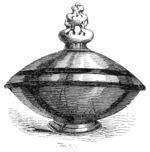was, perhaps, the mazer-bowl; its name was undoubtedly derived from the maple wood[1], of which it was usually made, although like bowls of more costly material bore the same appellation, which seems ultimately to have been given to shape, without reference to substance.
Mazers were of different sizes, great and little being named in the same inventories; sometimes they had covers[2], and a short foot or stem. The early wassail-bowl seems to have been shaped as a mazer. We give a cut of the "murrhine cup," presented to the abbey of St. Albans by Thomas de Hatfield, bishop of Durham, "which," says the recorder of the benefaction, "we in our times call 'Wesheyl[3].'" This vessel could not have been used in a very graceful manner; we perceive from illuminations that small ones were raised to the mouth in the palm of the hand; the larger sized would have needed both hands. The small mazer was called a "maselin," unless, indeed, Dan Chaucer borrowed this diminutive from the Latin to make a rhyme:—
"They fet him first the swete win,
And mede eke in a maselin."
The Rime of Sir Thopas.
Our ancestors seem to have been greatly attached to their mazers, and to have incurred much cost in enriching them. Quaint legends, in English or Latin, monitory of peace and good-fellowship, were often embossed on the metal rim and on the cover; or the popular, but mystic Saint Christopher engraved on the bottom of the interior, rose in all his giant proportion, before the eyes of the wassailer as he drained the bowl, giving comfortable assurance that on that festive day, at least, no mortal harm could befal him. But we may believe that occasionally art made higher efforts to decorate the
- ↑ Dutch maeser. In that valuable record of the usual household effects of the middle classes at the beginning of the fourteenth century, the assessment of a 15th upon the borough of Colchester, in the 29th of Edward the First, (Rot. Parl., i. 245,) mazers are frequently mentioned—"i. ciphus de mazero parvus pretii vj.d."—"i. ciphus de mazero pretii xviiid."—the highest value at which one is assessed being two shillings, and that price must have been owing to its size and workmanship, for had the material been silver, the fact would have been stated. These we may fairly assume to have been wooden bowls.
- ↑ "One mazer with one cover duble gilt weyth xxix onces,—ix.li. xiij.s. iiij.d."—Wills and Inventories (Surtees Society), p. 339.
- ↑ MS. Cotton. Nero D. vii. fo. 87.

